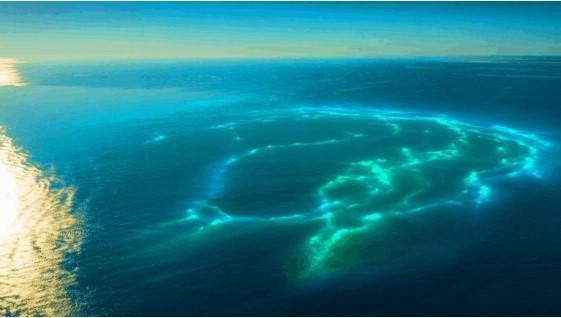
NASA Spots Glowing Waters Off Australia Caused by Plankton
In recent years, our understanding of the ocean’s importance in the Earth’s ecosystem has grown significantly. The vast expanse of our planet’s oceans covers over 70% of the Earth’s surface, and they play a crucial role in regulating the climate, providing half of the oxygen we breathe, and serving as a source of food for billions of people. Despite their significance, oceans are often shrouded in mystery, with many of their processes and phenomena still not fully understood.
However, thanks to advancements in satellite technology and NASA’s commitment to monitoring the health of our oceans, we are now able to gain a deeper understanding of these vital ecosystems. Recently, NASA satellites captured a striking image of the southern coast of Australia, revealing a massive phytoplankton bloom that glows with a vibrant turquoise light. This phenomenon is not only a breathtaking sight but also highlights the vital ecological role of phytoplankton in the marine food chain and carbon cycle.
What is Phytoplankton?
Phytoplankton are microscopic plants that live in the ocean and are the base of the marine food chain. These tiny organisms are responsible for producing a significant portion of the oxygen we breathe and absorb carbon dioxide from the atmosphere, making them a crucial component in the global carbon cycle. Phytoplankton are incredibly diverse, with over 1,000 species found in the world’s oceans.
The Turquoise Glow of Australia’s Southern Coast
The recent image captured by NASA’s satellites shows a massive bloom of phytoplankton off the coast of southern Australia. The bloom is visible from space, appearing as a vibrant turquoise color that stretches for hundreds of miles. This phenomenon is caused by the high concentration of phytoplankton in the water, which absorb chlorophyll and other pigments, giving them their distinctive color.
The turquoise glow is not just a striking visual effect; it is also an indication of the health and productivity of the ocean ecosystem. Phytoplankton blooms like this one are an important indicator of the ocean’s ability to support life and absorb carbon dioxide. NASA’s monitoring of these blooms helps scientists understand how the ocean is responding to climate change and how it is impacting the global carbon cycle.
The Importance of Phytoplankton in the Marine Food Chain
Phytoplankton are the primary source of food for many marine animals, from tiny krill to massive blue whales. They are the base of the marine food chain, providing energy and nutrients to the entire ecosystem. Phytoplankton are also an important food source for humans, with many species of fish and shellfish relying on them for their survival.
In addition to their importance in the food chain, phytoplankton also play a critical role in regulating the ocean’s chemistry. They absorb carbon dioxide from the atmosphere and use it to produce organic compounds, such as glucose, which are used to fuel their growth. When phytoplankton die and sink to the ocean floor, they take this carbon with them, helping to remove it from the atmosphere.
NASA’s Role in Monitoring Ocean Health
NASA’s commitment to monitoring the health of our oceans is a critical component of their overall mission to understand and protect our planet. By using advanced satellite technology, NASA is able to track changes in ocean temperatures, sea levels, and ocean chemistry, providing scientists with valuable insights into the impacts of climate change.
NASA’s satellites are equipped with specialized instruments that can detect changes in ocean color, temperature, and chemistry. These instruments are able to collect data on ocean currents, upwelling, and other processes that impact the health of marine ecosystems.
Conclusion
The recent image of the turquoise glow of Australia’s southern coast is a striking reminder of the importance of phytoplankton in the marine food chain and carbon cycle. NASA’s monitoring of these blooms provides scientists with valuable insights into the health of our oceans and the impacts of climate change.
As we continue to face the challenges of climate change, it is more important than ever that we have access to reliable and accurate data on the health of our oceans. NASA’s commitment to monitoring the health of our oceans is a critical component of their overall mission to understand and protect our planet.
News Source:
https://www.breezyscroll.com/world/nasa-turquoise-glow-australia-phytoplankton/






